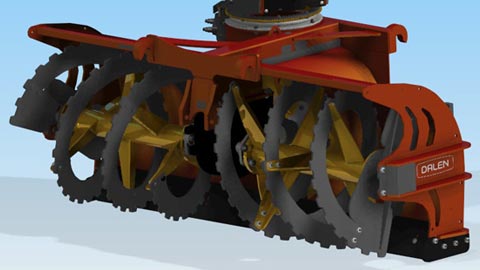Solution to improve product quality and durability
Solution to improve product quality and durability

Case Study
Using Solid Edge enables agricultural equipment manufacturer to compete with low-cost suppliers
Lid Jarnindustri
Lid Jarnindustri uses Siemens Digital Industries Software solution to improve product quality and durability
Staying alive
From modest beginnings as a metal factory in post-World War II Norway, Lid Jarnindustri AS (Lid Jarnindustri) has become a successful enterprise. In 65 years, the company has moved from being a makeshift producer of snow chains for bicycles to using product lifecycle management (PLM) tools to manufacture sturdy and advanced agricultural equipment. Solid Edge® software, from Siemens Digital Industries Software, has played an important role in that success as it has provided Lid Jarnindustri with a computer-aided design (CAD) system that has helped the company achieve flexible and efficient design solutions.
“Solid Edge is essential in our plant today,” says Jarand Mæland, chief of construction for Lid Jarnindustri. ”We use many of the parts and assemblies for several different products, sometimes unchanged, or with minor or major alterations. In addition, we use the revision manager capability to copy parts and assemblies into new projects.
“The savings are obvious and essential,” he says, noting that Norway is a high-cost country for manufacturing, so it is particularly important to keep costs under control. “Without state-of-the-art software and technology from Siemens Digital Industries Software, we probably wouldn’t exist today. The competition from low-cost suppliers would have strangled us. So the issue goes beyond savings. The issue is surviving and succeeding.”
Best laid plans
When the company was started in 1948, the founders intended to produce furniture locks and fittings for furniture – articles in great demand in postwar Norway. However, due to lack of raw materials, the company could not start production. Instead, they were able to procure two tons of rusted steel wire, which they used to make simple but useful bicycle snow chains. Cars were scarce at the time, so the bicycle was the preferred mode of transportation. Bicycle snow chains made the icy winter roads of Norway traversable.
Of course, the company did not possess any computerized tools, so the process of removing the rust and then making the chains presented quite a few challenges. The dealers soon discovered that the chains fell apart, and the whole production had to be withdrawn, resulting in substantial losses.
New and better chains were made, and put in the old packaging. Things were starting to look up, until one dealer informed the company that its brand name was already taken by a Norwegian bicycle producer. The chains had to be returned once more.
The bank wanted to stop financing the enterprise, but the local farmers backed the firm, and the new packaging was created. After replacing the original chains and packaging, Lid Jarnindustri had modest success selling the bicycle chains, and the firm was on its way to becoming a viable and prosperous factory.
Adopting more reliable methods
Trying and failing is no longer an option for Lid Jarnindustri because the manufacturing world has become a much more competitive place. The “gut engineering” that took place 65 years ago that resulted in a failed product has been replaced by digitally driven best practices.
“Previously, we used software that was relatively primitive and not very different from the old drawing board,” says Mæland. “But in 1998, we made the leap to Solid Edge to make our processes more efficient.”
Simulations are an important part of today’s product development at Lid Jarnindustri. By simulating both durability and functionality, the company doesn’t have to rely on lots of mechanical testing. This makes it possible to conduct projects much faster, and makes the communication with the production department much better, an extremely important consideration.
“Solid Edge makes it is possible for us to send sheet metal directly to robot folding and laser cutting, and yet maintain a very precise result at the other end,” says Mæland.
The company makes products in five categories: wood, road, snow, lift and grass. It manufactures products such as firewood processors, snow blowers, pallet forks and round bale handlers. Today, virtually all of the company’s products – which include 18 models – are constructed with Solid Edge, a core component of the Velocity Series™ portfolio. Lid Jarnindustri has over 80,000 Solid Edge files in stock, which makes it easy to retrieve, revise and alter existing and older products.
“Solid Edge enables us to make changes, simulate them and assemble new solutions with a minimum of time and effort,” Mæland says. “This also makes it easier for us to respond to feedback from our customers. The fact that the models are nearly identical to the finished product, and that we can perform many stress tests without actually making the products, is invaluable to us.”
